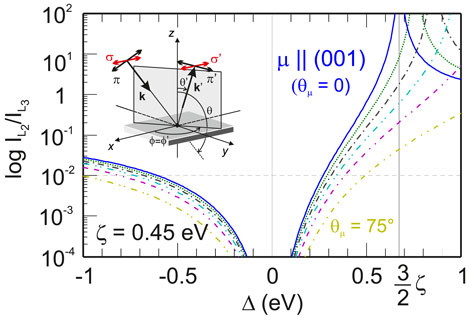- Home
- News
- Spotlight on Science
- Probing wave functions...
Probing wave functions in complex oxides with X-rays
11-02-2014
The ground and excited state wave functions of iridium oxides can be interrogated using resonant X-ray scattering techniques. For the first time, the dependence of the scattering cross-sections on the direction of the local magnetic moment has been examined. This led to the development of a formalism for the correct interpretation of previous experimental results and for the future exploration of the exotic properties of iridium oxides.
The physical and functional properties of advanced materials are often controlled by the subtle interplay of electronic, magnetic, structural and vibrational degrees of freedom. Prominent examples are thermo- and multiferroic materials and high-temperature superconductors. Iridate perovskites have entered the focus of interest as some of their representatives surprisingly display an insulating ground state. Further impetus for their study comes from their structural similarities to superconducting cuprates and the prediction that iridates may form new families of superconductors [1,2].
Common wisdom so far has held that metallic ground states should be displayed ubiquitously by 5d compounds such as iridates. However, even a moderate on-site Coulomb repulsion U, in the presence of the strong spin-orbit coupling (ζ) of Ir4+ (5d5 electronic configuration), can act to open a gap, hence leading to the formation of an insulating state [3,4]. This is normally referred to as the jeff = ½ ground state, whose realisation is subject to the perfect cubic symmetry of the crystal field. For lower crystal symmetries – in fact the common case for iridate perovskites – the tetragonal crystal field splitting D and its influence on the ground and excited state wave functions has to be taken into account.
We have developed a single-ion model to explain the relationship between spectra from resonant X-ray magnetic scattering (RXMS) and resonant inelastic X-ray scattering (RIXS) and the underlying electronic structure of an iridate oxide being studied. Our results reveal the full complexity of the relationship between ζ, Δ, and θµ, the angle of the magnetic moment with respect to the c-axis. This is illustrated in Figure 1 which reports the RXMS branching ratio – the intensity ratio of the RXMS intensity in the crossed-polarised scattering channel at the Ir L2 and L3-edge – as a function of Δ for a fixed value of ζ = 0.45 eV. Furthermore, the figure reveals a strong dependence of the branching ratio on the direction of the magnetic moment. A very similar behaviour is observed for the RIXS branching ratio (not shown). This can be intuitively understood considering that the RIXS process involves a spin-flip, in contrast to RXMS.
These findings have important implications: in general the jeff = ½ ground state cannot be inferred from the branching ratio for arbitrary magnetic moment directions. In turn, constraints on ζ and Δ allow the determination of θµ and the ground state wave function. Our theoretical framework will therefore guide the interpretation of resonant scattering results and allow a deeper understanding of the complex electronic structure of iridate oxides.
Principal publication and authors
Resonant X-ray scattering and the jeff = ½ electronic ground state in iridate perovskites, M. Moretti Sala (a), S. Boseggia (b,c), D.F. McMorrow (b,d), and G. Monaco (a,e), Physical Review Letters 112, 026403 (2014).
(a) ESRF
(b) University College, London (UK)
(c) Diamond Lightsource Ltd, Didcot (UK)
(d) Technical University of Denmark, Lyngby (Denmark)
(e) University of Trento, Trento (Italy)
References
[1] H. Watanabe, T. Shirakawa, and S. Yunoki, Physical Review Letters 105, 216410 (2010).
[2] F. Wang and T. Senthil, Physical Review Letters 106, 136402 (2011).
[3] B.J. Kim et al., Physical Review Letters 101, 076402 (2008).
[4] S.J. Moon et al., Physical Review Letters 101, 226402 (2008).
Top image: The jeff = ½ ground state wave function of an Ir4+ ion in an undistorted IrO6 octahedron (blue) and the 2px, 2py and 2pz orbitals of ligand oxygens (red).




